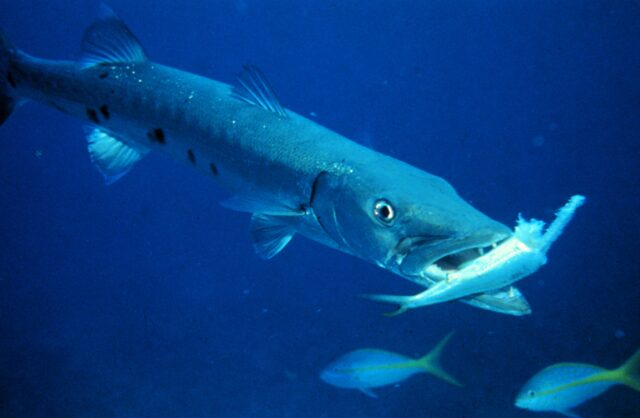The Great barracuda is amongst the top predators in their environment and use very highly developed smell and vision senses to locate their prey. When attacking, the barracuda will charge at fast speed (approximately 12 ms-1) and ram their target. They then unleash the power of their jaws which allows them to slice through their prey, even those larger than the barracuda itself. The jaw of the barracuda is formed in such a way that the upper and lower jaws form ‘rows’ of teeth. The top jaw has smaller serrated teeth on the outside and larger canines on the inside, and the teeth of the lower jaw fit between them when the mouth is shut. When the jaw closes this acts like scissors and slices through prey with ease.
What's Happening at Discovery Diving
Get all the latest info from our Instructors and Staff on our SCUBA Classes, Charters, Equipment and Special Events.
The fast and deadly Great Barracuda is Creature of the Month
- Font size: Larger Smaller
- Hits: 2730
- 0 Comments
- Subscribe to this entry
- Bookmark

Mostly found living on near-shore coral reefs in tropical and sub-tropical waters, excluding the East Pacific, the Great barracuda lives quite close to the surface of the water. It has however been known to take they occasional foray into open water and has been observed as deep as 100 meters. They can grow up to 2 metres in length and the largest know weight was approximately 45kg, which mean predators are in short supply. However, sharks, goliath groupers and even tuna have been known to feed on the smaller adults.

Photo credit: Albert Kok, CC BY-SA 2.5
The juvenile Great barracudas start life in amongst mangroves, sea grass and murky inshore waters as they are particularly susceptible to predation when they are small and young, but after about a year they are mature enough to move to the coral reefs where they will live to an age of between 14-19 years. Whilst the global distribution of the great barracuda is currently considered one species, they can be divided into four populations, found in the Indo pacific, Hawaiian Islands, west Atlantic/Caribbean and the east Atlantic.

Photo credit: National Park Service
The Great barracuda also has the infamy of containing high levels of ciguatoxin. Their toxic levels are traced back to dinoflagellates, which are a type of marine plankton that are at the bottom of the food web and are more commonly known for causing algal blooms. As those who prey upon them are also preyed upon, their concentration levels build up until they reach dangerously high levels amongst the apex predators, like the Great barracuda.
Ciguatera poisoning can be very harmful to humans when the flesh of reef fish, with high levels of the toxin, is eaten. It is thought to cause over 100 gastrointestinal and neurological symptoms.


